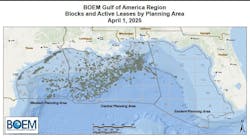Gulf of Mexico oil production set to increase
Offshore staff
WASHINGTON, D.C. – The US Energy Information Administration (EIA) forecasts crude oil production in the federal Gulf of Mexico (GOM) to increase in the next two years, according to the latest Short-Term Energy Outlook (STEO).
By the end of 2022, 13 new projects could account for about 12% of total GOM crude oil production, or about 200,000 b/d.
The GOM accounts for 15%-16% of US crude oil production. In 2020, GOM crude oil production averaged 1.65 MMb/d. Production is forecast to exceed 2020 levels, reaching 1.71 MMb/d in 2021 and 1.75 MMb/d in 2022. Since 2000, the highest crude oil production year was 2019 at 1.9 MMb/d, according to the EIA.
Large offshore projects take several years to develop. Four of the new projects will likely begin production in 2021 and nine more in 2022, according to Rystad Energy. Crude oil production is subject to geologic conditions, economics, and project timelines. The future oil markets remain uncertain, so future projects’ timelines may change accordingly, the EIA warned.
Hurricanes are a critical element in the GOM forecast. The Atlantic hurricane season is typically June 1-Nov. 30. Although eight new projects started crude oil production in 2020, annual production was lower than 2019 levels because of the COVID-19 pandemic-related shut-ins and the most active Atlantic hurricane season on record.
Hurricane Delta shut in 1.6 MMbbl of oil over two days in October, the highest peak shut-in of the hurricane season. However, the combined effects of Tropical Storm Marco, followed quickly by Hurricane Laura, led to 15 days of shut-ins. This more than doubled the total shut-in production from Hurricane Delta and resulted in the most shut-ins since 2008, the according to the EIA.
Colorado State University’s Seasonal Hurricane Forecasting forecasts that the 2021 Atlantic hurricane season will be above average, compared with the 40-year average. The university estimates eight hurricanes and 17 named storms.
To forecast hurricane outages in the STEO, the EIA uses historical data to determine an average percentage of outages for the Atlantic hurricane season. Historically, most GOM shut-ins occur in October. In 2020, hurricane-related disruptions started earlier than normal with Tropical Storm Marco and Hurricane Laura in August.
04/14/2021



